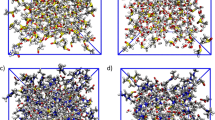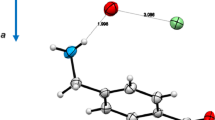Abstract
Phase diagrams of some binary aqueous systems with tetraalkylammonium fluorides are examined. The size of the hydrophobic moiety of the guest is consecutively varied in the series (i-C5H11)4−k(C4H9)kNF (k=0, 1, 2, 3) by replacing bulky isoamyl radicals with n-butyl radicals. Changes in clathrate formation caused by variations of the sizes and forms of guests are analyzed in the series (i-C5H11)k−4(C4H9)kNF−H2O (k=0, 1, 2, 3, 4). All tetraisoamylammonium fluoride hydrates are more stable than other hydrates of this series. The stability of the compounds increases due to the fact that the isoamyl radicals use the host cavities more effectively than the butyl radicals. In all hydrates of the series, tetragonal structures-I (TS-I), which were earlier thought typical only for hydrates of tetrabutylammonium salts, are formed. Hydrates of the orthorhombic system are formed until three isoamyl radicals have been replaced by butyl radicals. Hydrates with 26–28 water molecules (mp 27.4–34.6°C) are the most stable hydrates of the series, except for i-AmBu3NF·25.9 H2O, melting 0.3°C lower than the tetragonal hydrate in the same system. All compounds are defined chemically, and for some of them crystal data are given.
Similar content being viewed by others
References
R. K. McMullan and G. A. Jeffrey,J. Chem. Phys.,31, No. 5, 1231–1234 (1959).
D. Feil and G. A. Jeffrey, —ibid.,35, No. 5, 1863–1873 (1961).
H. Nakayama,Bull. Chem. Soc. Jpn.,54, 3717–3722 (1981).
H. Nakayama, —ibid.,55, No. 2, 389–393 (1982).
H. Nakayama and K. Watanabe, —ibid.,49, No. 5, 1254–1256 (1976).
H. Nakayama and S. Torigata, —ibid.,57, No. 1, 171–174 (1984).
H. Nakayama and H. Usui, —ibid.,59, No. 3, 833–837 (1986).
R. K. McMullan, M. Bonamico, and G. A. Jeffrey,J. Chem. Phys.,39, No. 12, 3295–3310 (1963).
M. Bonamico, G. A. Jeffrey, and R. K. McMullan, —ibid.,37, No. 10, 2219–2231 (1962).
G. Beurskens, G. A. Jeffrey, and R. K. McMullan, —ibid.,39, No. 12, 3311–3315 (1963).
G. A. Jeffrey, in:Inclusion Compounds, Ch. 5, Academic Press, London (1984), pp. 135–190.
Yu. A. Dyadin, I. I. Yakovlev, I. V. Bondaryuk, et al.,Dokl. Akad. Nauk SSSR,203, No. 5, 1068–1071 (1972).
Yu. A. Dyadin, L. S. Aladko, I. I. Yakovlev, and I. S. Terekhova,Izv. Sib. Otd. Akad. Nauk SSSR,1, No. 2, 55–61 (1972).
Yu. A. Dyadin, L. S. Aladko, and I. I. Yakovlev, —ibid.,5, No. 12, 49–60 (1971).
T. V. Rodionova, Yu. A. Dyadin, K. A. Udachin, et al.,Sib. Khim. Zh.,2, 54–58 (1992).
J. Lipkowski, K. Suwinska, T. Rodionova, et al.,J. Incl. Phen., No. 17, 137–148 (1994).
V. V. Kokovkin, A. M. Nemirovskii, L. Kh. Kravchenko, et al.,Zavod. Lab., No. 7, 8–12 (1987).
J. Mitchell and D. M. Smith,Aquametry, New York (1948).
Yu. A. Dyadin, I. S. Terekhova, et al.,Zh. Strukt. Khim.,17, No. 4, 665–671 (1976).
Yu. A. Dyadin and L. S. Kiselyova,Izv. Sib. Otd. Akad. Nauk SSSR, Ser. Khim. Nauk,198, No. 1, 124–129.
Yu. A. Dyadin, F. V. Zhurko, et al.,J. Incl. Phen. Mol. Rec. Chem.,10, 39–56 (1991).
K. W. Allen,J. Chem. Phys.,41, No. 3, 840–844 (1964).
Additional information
Institute of Inorganic Chemistry, Siberian Branch, Russian Academy of Sciences. Institute of Physical Chemistry, Polish Academy of Sciences. Translated fromZhurnal Strukturnoi Khimii, Vol. 36, No. 3, pp. 501–508, May–June, 1995.
Translated by L. Smolina
Rights and permissions
About this article
Cite this article
Rodionova, T.V., Dyadin, Y.A., Udachin, K.A. et al. Clathrate formation in (i-C5H11)4−k (C4H9) k NF−H2O (k=1,2,3) binary systems. J Struct Chem 36, 458–464 (1995). https://doi.org/10.1007/BF02578533
Received:
Issue Date:
DOI: https://doi.org/10.1007/BF02578533




